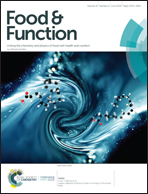Effects of convective drying and freeze-drying on the release of bioactive compounds from beetroot during in vitro gastric digestion
Abstract
Drying may alter the microstructure of vegetables and influence the release of bioactive compounds during digestion. The effects of convective drying (at 60 °C and 2 m s−1; CD) and freeze-drying (at −50 °C and 30 Pa; FD) on the microstructure (evaluated using scanning electron microscopy (SEM) and image analyses with ImageJ software) of beetroot and the kinetics of biocompound release (total polyphenol content (TPC) and antioxidant activity (AA)) during 180 min of in vitro gastric digestion have been studied. Raw beetroot was used as the control. Drying promoted the collapse of cell walls causing volume shrinkage that resulted in a greater cell number per area unit; meanwhile in vitro digestion caused cell structure disruption, which resulted in a lower cell number per area unit. Drying promoted decreases of TPC (42% in CD and 29% in FD) and AA (66% in CD and 63% in FD) of beetroot. However, release of TPC and AA from dried samples during digestion was 82% (CD) and 76 (FD) % higher than from the raw sample. The Weibull model allowed the satisfactory modelling of the TPC and AA release kinetics (mean relative error of simulation lower than 8.5%).



 Please wait while we load your content...
Please wait while we load your content...